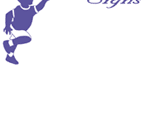|
The following red flags may
indicate a child is at risk for autism spectrum disorder, and is in need of an immediate
evaluation.
In clinical terms, there are a few “absolute indicators,” often referred
to as “red flags,” which indicate a child should be evaluated.
For a parent, these are the “red flags” your child should be screened
to ensure that s/he is on the right developmental path.
Red Flags of Autism Spectrum Disorder:
If your baby shows two or more of these signs, please ask
your pediatric healthcare provider for an immediate evaluation.
Impairment in Social Interaction:
- Lack of appropriate eye gaze
- Lack of warm, joyful expressions
- Lack of sharing interest or enjoyment
- Lack of response to name
Impairment in Communication:
- Lack of showing gestures
- Lack of coordination of nonverbal communication
- Unusual prosody (little variation in pitch, odd
intonation, irregular rhythm,
unusual voice quality)
Repetitive Behaviors & Restricted
Interests:
- Repetitive movements with objects
- Repetitive movements or posturing of body, arms, hands,
or fingers
Wetherby, A., Woods, J., Allen, L., Cleary,
J., Dickinson, H., & Lord, C. (2004). Early indicators of autism
spectrum disorders in the second year of life. Journal of Autism
and Developmental Disorders, 34, 473-493. Based on research at
the Florida
State University FIRST WORDS® Project.
“Most mommies and daddies tell me 'I thought there was a problem at 14 or
15 months...and they told me let’s wait and see because sometimes some kids grow
out of it.’
Well, that’s not a good answer. We’ve got to make the distinction between less
important problems, where we can wait and see from core problems, which involve
a lack of reciprocity and a lack of getting to know your world. For these core
problems, we have to act on it yesterday. We can’t wait nine months, we can’t
wait two months.” (Stanley I. Greenspan, M.D., Child Psychiatrist)
Back to top
Next page => |




